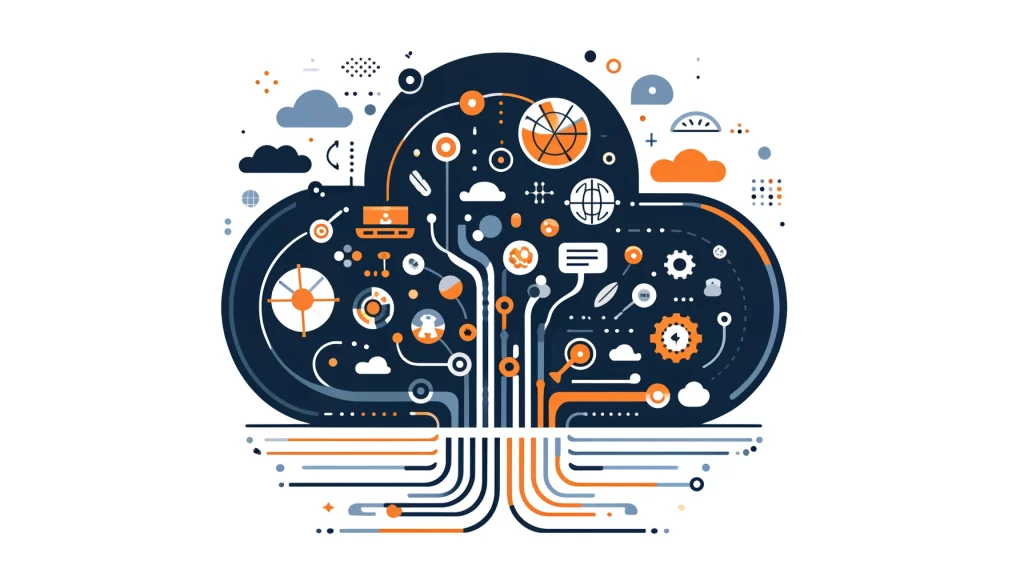
The Role of Data Fabric in Supporting Digital Transformation

A data fabric is a framework designed to seamlessly integrate various data pipelines and cloud environments. This design brings together data systems, boosts security and privacy, and makes it easier for employees to access data.
Managing complex IT environments becomes easier as technology advances. This is especially true with the use of edge computing, AI, hybrid clouds, and IoT. A data fabric solution can help streamline this process.
How Data Fabric Architecture Works
Data fabric architecture leverages auto-integration capabilities to connect business applications with data sources. It uses knowledge graphs to analyze relationships between data sources, converting them into a consistent format. This consistency makes data easily accessible and helps avoid bottlenecks.
Automating data integration involves detecting existing data and metadata, creating a unified data layer from the source level. This process uses analytics, orchestration, and automated insights generation. Data fabrics can set up two-directional integration with various components of a technology stack.
Benefits of Data Fabric Technology
Data fabric technology addresses complex data challenges, enabling organizations to use multiple data sources across different locations. It helps solve intricate data issues and supports challenging use cases. The agility allows organizations to adapt systems as needed while ensuring synergy across all operating environments.
For example, a global retail company can use data fabric to integrate sales data from different regions. This integration provides a unified view of their sales performance, helping them optimize inventory and marketing strategies.
Enhancing Real-Time Decision-Making
Data fabric technology is invaluable for real-time decision-making. By integrating various data sources, organizations can gain instant insights into their operations. For example, a logistics company can monitor shipments in real time, identifying delays and rerouting deliveries as needed. This immediate access to data ensures more responsive and efficient operations.
Supporting Digital Transformation
Digital transformation initiatives benefit greatly from fabric technology. By providing a unified data environment, data fabrics facilitate the implementation of new technologies and processes.
A manufacturing company can use IoT sensors on their production line. They can also use data fabric to analyze data. This helps them improve production and decrease downtime.
Enabling Advanced Analytics
Data fabric supports advanced analytics by providing a consistent and comprehensive data layer. This capability is crucial for businesses that rely on insights.
For example, a financial services company can use data fabric to bring together customer data from different sources. This allows for a thorough analyzing of customer behavior and preferences. This insight can drive personalized marketing campaigns and improve customer retention.
Data Fabric vs. Data Mesh
Data fabric and data mesh are two different approaches to data management. A data mesh emphasizes decentralized teams to manage data at scale. Each team, or pod, is responsible for its data sets, governance, and processes. Treat data as a product, considering its storage, pipelines, and quality as part of its value.
In contrast, data fabric automates the discovery, linking, and distribution of data assets. It focuses on the technology aspect of data management, ensuring data is high-quality and accessible. Data fabric views data as a commodity for processing for value extraction.
Implementing Data Fabric
Implementing a data fabric involves harmonizing various databases, storage locations, and data management policies. A unified platform should serve as the foundation to avoid creating silos and ensure efficiency of operations. Start small with an operating unit or specialized data set, and scale up as needed.
Addressing Issues and Silos
Issues of operations and silos can arise if the implementation of data fabric technology is not correct. Creating a unified platform helps mitigate these challenges. For example, a bank can start using the fabric in customer service and then expand it to other departments.
Harmonization and Unification Challenges
Both carry certain risks. Location independence might cause performance issues and high data transfer charges in hybrid or multi-cloud environments. For example, if an international company frequently moves data between clouds, it could incur significant costs. Managing data movement efficiently is crucial to avoid these pitfalls.
Handling Databases and APIs
Databases and APIs often use different access mechanisms. An effective fabric strategy incorporates a common access/query mechanism without excluding specialized APIs. This approach ensures existing applications continue to function while new ones integrate smoothly.
Best Practices for Data Fabric Tools
Adopting a DataOps process is vital for leveraging data fabric technology. DataOps ensures a close connection between data tools, processes, and users. It helps users trust the data, use tools easily, and apply insights to improve operations.
Compliance and Regulatory Requirements
Understanding compliance and regulatory requirements is essential when implementing a data fabric. The architecture can impact security, compliance, and governance. A comprehensive environment provided by data fabric reduces the attack surface and lowers the risk of exposing sensitive data.
For instance, a healthcare provider must comply with HIPAA regulations. With a data fabric, they ensure only authorized personnel access patient data, staying compliant and reducing breach risks.
Enabling Native Code Generation
Native code generation is a critical feature of data fabric. It allows for the automatic creation of integration code in various languages like Spark, Java, and SQL. This capability accelerates digital transformation and simplifies the introduction of new data systems.
Adapting to Edge Computing
Adapting data fabric to edge computing involves placing major data-related tasks in a dedicated edge layer. The central data fabric closely links to this distributed layer. For example, a smart factory can use an edge the fabric to calculate product characteristics on the production line. This setup reduces the need for centralized cloud inputs, enabling faster automated actions with less overhead.
Improving Security with Data Fabric
Data fabric enhances security by providing central control over all IT assets. It adds security layers like multi-factor access, strong passwords, and SSH keys. Without a central system, organizations might need to set up directory services for each cloud. This can lead to flawed efficiency and security.
A tech company using AWS and Azure can employ data fabric to manage access across all platforms. This centralizes security controls and ensures consistent access policies.
Case Study: Retail Industry Application
Consider a large retail chain with stores across multiple regions. The company wants to integrate sales data, inventory levels, and customer feedback to improve operations. By implementing a data fabric, the company can create a unified data layer that consolidates information from all stores. This integration lets headquarters monitor sales trends in real time, adjust inventory, and quickly respond to customer feedback.
Case Study: Healthcare Sector
In the healthcare sector, data fabric can reinvent patient care and efficiency of operations. A hospital network can integrate patient records, treatment plans, and research data using it. This integration ensures that doctors have access to comprehensive patient histories, leading to better-informed treatment decisions. Additionally, the hospital can analyze treatment outcomes across different facilities to identify best practices and improve overall care quality.
Overcoming Implementation Challenges
Implementing data fabric is not without its challenges. Organizations must ensure that all data sources are compatible and that the integration process does not disrupt existing operations. This requires careful planning and a phased approach. Starting with a small pilot project can help identify potential issues and develop solutions before scaling up.
For instance, a financial institution might start by integrating customer data from a single department. After refining and testing the integration, it can expand to include more departments and data sources.
Future Trends in Data Fabric Technology
As technology evolves, data fabric solutions will continue to advance. Emerging trends include the integration of artificial intelligence and machine learning to enhance data processing and insights generation. Additionally, edge computing will become more prevalent, with the fabrics adapting to support decentralized data processing.
Organizations must stay abreast of these trends to fully leverage the capabilities of data fabric technology. By investing in continuous learning and development, companies can ensure they are prepared to meet future data management challenges.
Conclusion
Data fabric is essential for managing digital identities and controlling access to resources. It helps prevent unauthorized access, mitigate security risks, simplify user management, boost productivity, reduce IT costs, and ensure compliance with regulatory requirements. As organizations transition to cloud-based solutions, it will remain crucial for securing digital identities and protecting sensitive information.
Investing in data fabric technology provides organizations with a robust framework to handle complex data challenges, enhance security, and support digital transformation efforts. Organizations can stay ahead by using data fabric for real-time insights and following regulations.
